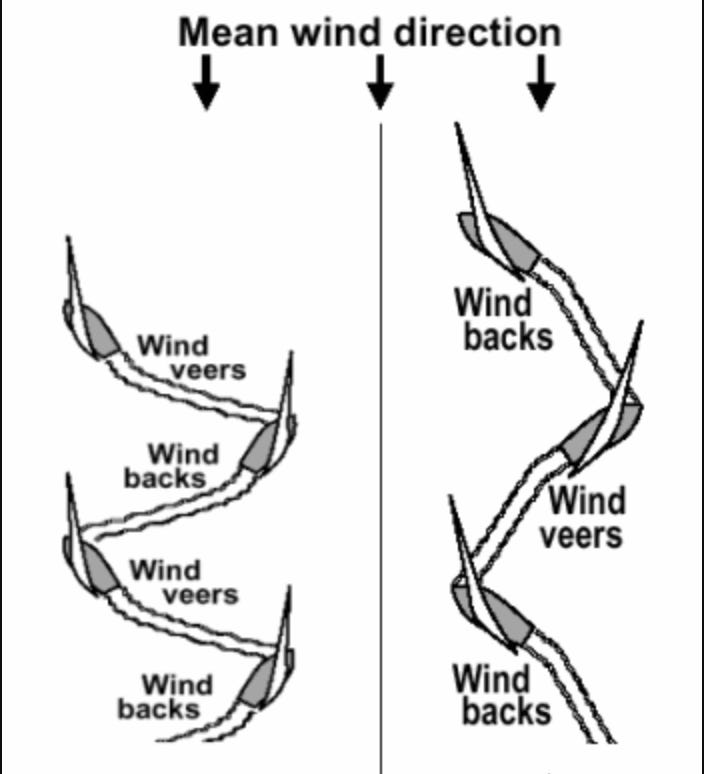I grew up racing small sailboats. Racing sailboats is a game of physics, strategy and math as you try to zig-zag your way to the next mark along a shorter, faster line than anyone else. There are more variables in sailing than in most sports, but let’s focus for now on oscillations, whence this newsletter derives its name.
I remember one moment when understanding oscillations opened up a new world for someone - my Dad.
Some days, the wind oscillates - it changes direction back and forth within a relatively consistent, relatively predictable range, at a relatively consistent cadence. How well you position yourself to take advantage of that recurring pattern while racing makes a huge difference - you can eke out some predictable gains if you’re in the right spot.
Dad, who won national titles in simpler times, wasn’t into ‘getting the numbers’ ahead of races, preferring to sail in a seat-of-the-pants fashion, even as his competition had evolved, technically. But one weekend, I convinced him that spending a half hour sailing the course before the race to understand the consistent shifts would give us a dataset to help make decisions, and that it was worth it.
He was, at this point, on the verge of hanging up his racing boots - a few years at the back of the fleet had sucked a lot of the enjoyment out of it for him. Doing additional homework seemed like further unnecessary effort. But it would give us an advantage. We would start the race understanding a pattern, and so he yielded. Off the start line, we quickly got in sync with the oscillations we had seen, and used them to sail a shorter, faster set of zig-zags upwind to the first mark than those who didn’t spot or use the pattern.
All of a sudden, we weren’t at the back of the fleet, we were in third place, within fighting distance of first. The boat was alive with new energy and possibility. We finished that race in second place, and I never had to convince Dad to ‘get the numbers’ again. In fact, he convinced himself he had a few good years of racing left in him and set out to buy and helm a boat himself after a lifetime of crewing a shared boat. Understanding that form of pattern recognition had transformed his perception of this huge part of his life, reintroduced the possibility of success to it, and made it enjoyable once more.
Pattern recognition is obviously incredibly transferrable. If you can teach a young sailor how to identify oscillations on the racecourse, you can probably teach them to spot patterns and use them to make good decisions in other areas of their life, and that’s true for many aspects of the sport. I taught sailing to youngsters in my teens and twenties, both how to race and how to live aboard boats. When I moved from coaching racing to more experiential education, the transferrability of what you learn ‘simply messing about in boats’ really hit home. (Nobody helped me join the transferrable dots like this, regrettably, so here I am shilling content for free on Substack and a blog).
Training yourself to recognize patterns means you’re setting yourself up to spot the indicators that suggest it’s time to make a change. Sell a stock. Buy a home. End a relationship. Take a rest. Stop drinking so much (On this latter point, I spent a year gathering data on my own behavior and made a major change). Hedge fund legend and author Ray Dalio also talks about this eloquently on the a16z podcast.
On the water, you do your research and then sail fast, with an eye on your compass heading. If the number deviates above the high end of the range you’ve observed, you tack and head the other direction until the number deviates below the low end of the range, at which point you tack back, gaining each time you do so, in theory. You stay in the groove.
If the number deviates outside of the range you identified when ‘getting the numbers’, and stays out, you know there’s some new force at play pushing the numbers beyond the observed range. In sailing we call it a ‘persistent shift’, in that the wind keeps moving in one direction, rather than oscillating back and forth. In life, it often means a paradigm has shifted. You need to know why - and fast - so that you can adjust to the new reality, and be early to do so.
So that’s oscillations for you. It’s not just a fancy, obscure word to name a Substack. It’s a way of thinking.
If you’re reading this on my website, subscribe to my email newsletter for more musings on how to achieve growth in work, life, digital product and wherever the oscillations suggest you head. If you’re reading this via ‘Oscillations’, well, you’re already in the groove. See you again when things shift back this way.




